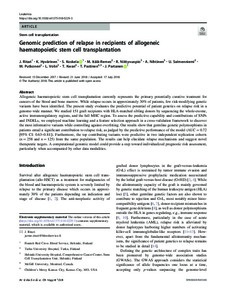Genomic prediction of relapse in recipients of allogeneic haematopoietic stem cell transplantation
J. Ritari; K. Hyvärinen; S. Koskela; M. Itälä-Remes; R. Niittyvuopio; A. Nihtinen; U. Salmenniemi; M. Putkonen; L. Volin; T. Kwan; T. Pastinen; J. Partanen
https://urn.fi/URN:NBN:fi-fe2021042719749
Tiivistelmä
Allogeneic haematopoietic stem cell transplantation currently represents
the primary potentially curative treatment for cancers of the blood and
bone marrow. While relapse occurs in approximately 30% of patients, few
risk-modifying genetic variants have been identified. The present study
evaluates the predictive potential of patient genetics on relapse risk
in a genome-wide manner. We studied 151 graft recipients with
HLA-matched sibling donors by sequencing the whole-exome, active
immunoregulatory regions, and the full MHC region. To assess the
predictive capability and contributions of SNPs and INDELs, we employed
machine learning and a feature selection approach in a cross-validation
framework to discover the most informative variants while controlling
against overfitting. Our results show that germline genetic
polymorphisms in patients entail a significant contribution to relapse
risk, as judged by the predictive performance of the model (AUC = 0.72
[95% CI: 0.63–0.81]). Furthermore, the top contributing variants were
predictive in two independent replication cohorts (n = 258 and n = 125)
from the same population. The results can help elucidate relapse
mechanisms and suggest novel therapeutic targets. A computational
genomic model could provide a step toward individualized prognostic risk
assessment, particularly when accompanied by other data modalities.
Kokoelmat
- Rinnakkaistallenteet [27094]
